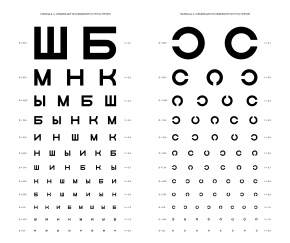Golovin–Sivtsev table
The Golovin–Sivtsev Table (Russian: Таблица Головина-Сивцева) is a standardized table for testing visual acuity, which was developed in 1923 by Soviet ophthalmologists Sergei Golovin and D. A. Sivtsev.[1] In the USSR It was the most common table of its kind, and as of 2008 its use is still widespread in several post-Soviet states.[2]
| Golovin–Sivtsev table | |
|---|---|
| Medical diagnostics | |
 Golovin–Sivtsev Table | |
| Purpose | testing visual acuity |
The table consists of two parts with 12 rows each. A value D indicated to the left of each row gives the distance in meters from which a person with a visual acuity of 1.0 can read the corresponding row. A value V indicated to the right gives the minimum visual acuity needed to read the row from a distance of 5 meters. The rows represent visual acuity values between 0.1 and 2.0.[3]
The left part consists of series of the Cyrillic letters Ш, Б, М, Н, К, Ы, and И in a definite order. In the first row the size of a character is 70 mm, in the second row it is 35 mm, 7 mm in a row where visual acuity is 1.0, and 3.5 mm in the last row. The width of each character is equal to its height.
For visual acuity of 1.0, one needs to be able visually identify black from white at an angle of 1 arcminute. This covers the sign contours of Cyrillic letters as well as Landolt C symbols.
A sign is 7 mm in size, and it has a gap 1⁄5 of a sign size as a standard. A gap of 1.4 mm over 5 m distance gives an angle of around 1 arcminute (0.96 arcminutes).
The right part of the table consists of series of Landolt C symbols.
References
- (in Russian) Refraction and acuity
- (in Russian) Golovin–Sivtsev Table for determining the visual acuity
- (in Russian) Some information on Golovin–Sivtsev Table — that website as a whole doesn't seem to be reliable, but it seems to present reliable information on Golovin-Sivtsev Table dimensions